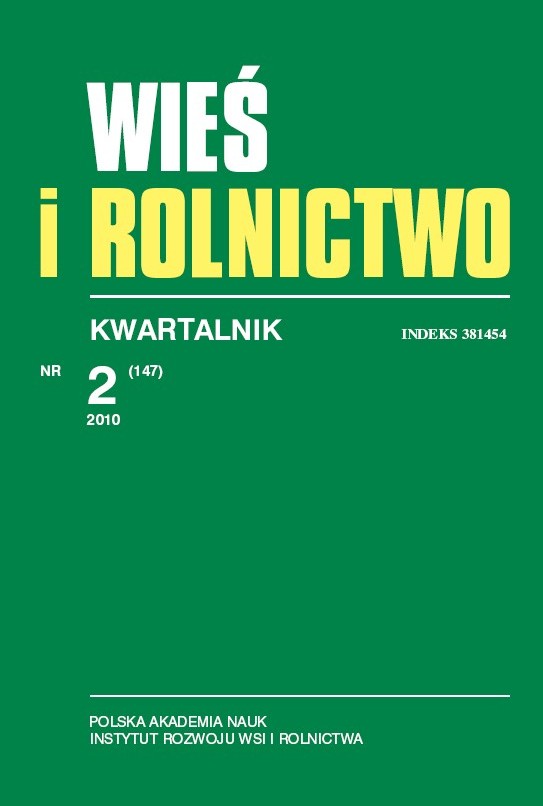Divestments in Agricultural Farms – Essence, Definitions, Division
DOI:
https://doi.org/10.53098/wir.2010.2.147/06Keywords:
agricultural farm, restructuring, divestments, economic collapseAbstract
Processes leading to reductions in the agricultural production of farms or to the abandonment of such production are becoming more and more frequently observable. Simultaneously, the process of relocation of resources is under way, which leads to the transfer of a considerable part of these resources to non-agricultural sectors of the economy. Such phenomena are being described in scientific literature as an economic collapse and bankruptcy of agricultural farms, which is unjustified in many cases. Decisions to limit production and reduce the engagement of the resources of farmers’ families in agricultural production can be seen as elements of the restructuring of specific economic entities that agricultural farms are. One of the strategic options of such restructuring can be divestments. In the presented paper efforts were launched to adapt the term “divestments” for the purposes of agricultural economics, which is indispensable to facilitate the analysis and description of processes occurring in agricultural farms. The considerations included in the paper do not cover all aspects of the problem. It is necessary to examine the scale, the course, the structure and the effectiveness of divestments in agriculture for these issues have not been described so far in any publications.References
Błąd M., 2008: Wielofunkcyjność gospodarstw rolniczych. Istota, zakres i uwarunkowania. „Wieś i Rolnictwo” 1 (138): 104–123. DOI: https://doi.org/10.53098/wir.2008.1.138/06
Boddewyn J.J., 1976: International Divestment. A Survey of Corporate Experience. Business International of Corporate Experience. Business International, New York.
Chastin C.E., 1987: Divestiture: antidote to merger mania. ”Business Horizons” 30, 6. DOI: https://doi.org/10.1016/0007-6813(87)90051-6
Decker C., van der Velden R., 2006: Desinvestition von Unternehmensteilen aus der Sicht des Ressourcen- und Kompetenzansatzes. In: Neue Perspektiven des Strategischen Kompetenzmanagements. Hrsg. C. Burmann, J. Freiling, M. Hülsmann, Wiesbaden: 221–242. DOI: https://doi.org/10.1007/978-3-8350-9313-3_8
Drucker P.F., 1985: Innowacja i przedsiębiorczość. PWE, Warszawa Foster R., Kaplan S., 2003: Twórcza destrukcja. Galaktyka, Łódź.
Garbusiewicz W., 1995: Istota rozwoju przedsiębiorstwa. „Zeszyty Naukowe AE w Poznaniu” 225.
Greiner L.E., 1972: Evolution and resolution as organization grow. ”Harvard Business Review” 50, 4. Grzesiuk A., 2006: Dywestycje w internacjonalizacji handlu. „Ekonomika i Organizacja Przedsiębiorstwa” 2 (673).
Harrigan K.R., Porter M.E., 1983: End-game strategies for declining industries. ”Harvard Business Review” 61, 4.
Haus B., 2003: Inwestycje i dywestycje gospodarcze przedsiębiorstw. „Prace Naukowe AE we Wrocławiu” 974: 300–309.
Klepacki B., 1997: Produkcyjne i ekonomiczne przystosowania gospodarstw prywatnych do zmian warunków gospodarowanie. Wydawnictwo SGGW, Warszawa.
Lovejoy F.A., 1971: Divestment for Profit. Financial Executives Research Foundation, New York. Markides C.C., Berg N.A., 1992: Good and bad divestment: the stock verdict. ”Long Range Planning” 25, 2. DOI: https://doi.org/10.1016/0024-6301(92)90187-7
Marona B., 2005: Restrukturyzacja majątkowa w sprywatyzowanych przedsiębiorstwach. „Zeszyty Naukowe AE w Krakowie” 687.
Musiał W., 2009: Rozważania nad upadłością gospodarstw rodzinnych w Polsce. „Wieś i Rolnictwo” 1 (142). DOI: https://doi.org/10.53098/wir.2009.1.142/03
Musiał W., Wojewodzic T., 2008: Przesłanki upadku ekonomicznego gospodarstw rolniczych na obszarach górzystych. „Problemy Zagospodarowania Ziem Górskich PAN” 55.
Osbert-Pociecha G., 1995: Dywestycje – niedoceniana opcja strategiczna. „Przegląd Organizacji” 12. DOI: https://doi.org/10.33141/po.1995.12.04
Osbert-Pociecha G., 1996: Racjonalność decyzji dywestycyjnych. „Prace Naukowe AE we Wrocławiu” 725.
Osbert-Pociecha G., 1998: Dywestycje w przedsiębiorstwie. „Prace Naukowe AE we Wrocławiu” 794.
Osbert-Pociecha G., 2004: Twórcza destrukcja jako uwarunkowanie innowacyjnego rozwoju przedsiębiorstwa. „Prace Naukowe AE we Wrocławiu” 1045.
Peters T.J., Waterman R.H., 1982: In Search of Excellance Lessons for American’s Best-Run Companies. Harper and Row Publishers, New York.
Prusak B., 2002: Upadłość – mit klęski, czy szansa na odrodzenie. Prace Naukowe Katedry Ekonomiki i Zarządzania Przedsiębiorstwem. 1. Red. H. Różańska. Wydawnictwo Politechniki Gdańskiej, Gdańsk.
Schumpeter J.A., 1985: Kapitalizm, socjalizm i demokracja. PWN, Warszawa.
Stanisławski J., 1996: Wielki słownik angielsko-polski. PW Wiedza Powszechna, Warszawa.
Straszyński W., 1989: Zaniechanie niektórych rodzajów działalności. „Organizacja i Kierownictwo” 1.
Tomaszewski M., 2000: Dywestycje jako element strategii przedsiębiorstwa. „Zeszyty Naukowe Uniwersytetu Szczecińskiego” 277: 135–143.
Tomczak F., 2005: Gospodarka rodzinna w rolnictwie. Uwarunkowania i mechanizmy rozwoju. IRWiR PAN, Warszawa.
Wojewodzic T., 2008a: Proces ograniczania produkcji przez gospodarstwa suplementarne. „Folia Universitatis Agriculturae Stetinensis, Oeconomica” 265 (52).
Wojewodzic T., 2008b: Perspektywy gospodarstw suplementarnych Pogórza Zachodniobeskidzkiego i Beskidów Zachodnich. „Problemy Rolnictwa Światowego” 4 (XIX): 456–466. DOI: https://doi.org/10.22630/PRS.2008.4.58
Downloads
Article file downloads
Pages
How to Cite
Issue
Section
License
Copyright (c) 2010 Wieś i Rolnictwo

This work is licensed under a Creative Commons Attribution 4.0 International License.










